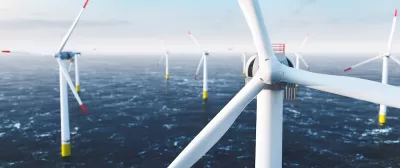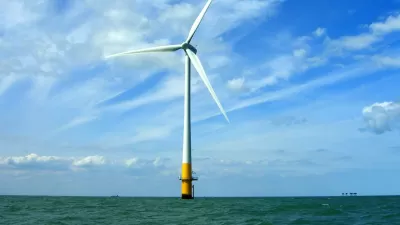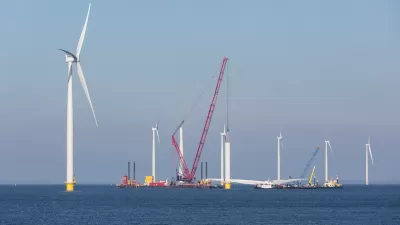The first commercial-scale offshore wind installation in the United States is powering roughly 70,000 homes in Long Island, New York.

The South Fork Wind Farm off the coast of Montauk, New York is the nation’s first commercial-scale offshore wind farm and a bright spot in a struggling industry that “offers tangible evidence that wind projects can work,” writes Pippa Stevens for CNBC News.
The project produces enough power for 70,000 homes annually, which it sells to the Long Island Power Authority. “Each turbine is connected to an offshore substation – the first of its kind built in the U.S. – which is connected to the local power grid in East Hampton, New York, via a 65-mile subsea and underground cable.”
The growth of the offshore wind industry has come in fits and starts, with interest rates and an uncertain, specialized supply chain driving up project costs and forcing companies to cancel some projects altogether. Because operators sign long-term contracts with power purchasers long in advance of construction, ballooning costs can make some projects financially unfeasible.
“The U.S. does have 58 gigawatts of capacity under development, according to American Clean Power, but some of those projects won’t come online for years, and there is no guarantee all of them will be built.” However, industry experts are optimistic that the sector is in a period of readjustment and will bounce back as components and skilled labor become more available.

Study: Maui’s Plan to Convert Vacation Rentals to Long-Term Housing Could Cause Nearly $1 Billion Economic Loss
The plan would reduce visitor accommodation by 25,% resulting in 1,900 jobs lost.

North Texas Transit Leaders Tout Benefits of TOD for Growing Region
At a summit focused on transit-oriented development, policymakers discussed how North Texas’ expanded light rail system can serve as a tool for economic growth.

Using Old Oil and Gas Wells for Green Energy Storage
Penn State researchers have found that repurposing abandoned oil and gas wells for geothermal-assisted compressed-air energy storage can boost efficiency, reduce environmental risks, and support clean energy and job transitions.

Private Donations Propel Early Restoration of Palisades Playground
Los Angeles has secured over $1.3 million in private funding to restore the Pacific Palisades playground months ahead of schedule, creating a modern, accessible space that supports community healing after recent wildfires.

From Blight to Benefit: Early Results From California’s Equitable Cleanup Program
The Equitable Community Revitalization Grant (ECRG) program is reshaping brownfield redevelopment by prioritizing projects in low-income and environmental justice communities, emphasizing equity, transparency, and community benefits.

Planting Relief: Tackling Las Vegas Heat One Tree at a Time
Nevada Plants, a Las Vegas-based nonprofit, is combating the city’s extreme urban heat by giving away trees to residents in underserved neighborhoods, promoting shade, sustainability, and community health.
Urban Design for Planners 1: Software Tools
This six-course series explores essential urban design concepts using open source software and equips planners with the tools they need to participate fully in the urban design process.
Planning for Universal Design
Learn the tools for implementing Universal Design in planning regulations.
Ascent Environmental
Borough of Carlisle
Institute for Housing and Urban Development Studies (IHS)
City of Grandview
Harvard GSD Executive Education
Toledo-Lucas County Plan Commissions
Salt Lake City
NYU Wagner Graduate School of Public Service





























